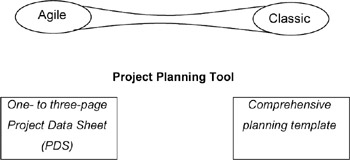An Agile Planning Tool
There is one planning tool that I've found to be exceptionally effective when used on the agile project. This is the Project Data Sheet (PDS). The PDS is a one- to three-page executive summary of a project that covers both classic and agile elements of project management required for success, such as a project description, objectives, milestones, timeline, and resource estimates. It gets the job done and is "light" enough that it doesn't inflict undo pain on the team, which is exactly what we want in an agile environment.
First and foremost, the Project Data Sheet is a communication tool. By summarizing all of the critical characteristics of your project into the concise PDS format, you can easily share your project ideas with management, contributors, other project managers, and program managers to gain their support and feedback. If you find yourself running projects in an agile environment, it is likely that you have numerous smaller projects taking place simultaneously. Some projects are independent but many are interdependent. To keep the many projects aligned with business objectives and make the most efficient use of valuable resources, it is important that all project managers be able to concisely describe their project. Creating a "deck of PDS's" allows management to readily assess the overall project portfolio without having to go into a question-and-answer session with each project manager just to get basic information. Everyone is stretched for time. Using the PDS format will greatly reduce the time and energy required of the project stakeholders.
| Agile Strategy | Use the Project Data Sheet format to create an executive summary of the project. The PDS, in turn, will provide a valuable communication tool in keeping the project on task to meet technical and business objectives. |
The second major benefit of using the PDS format is that it is short and concise, unlike the comprehensive planning templates commonly created during classic PM (see Figure 7-8). When backed up by a detailed Gantt chart through the next major milestones, the PDS makes it significantly easier for the project manager to maintain the high-level and detailed parts of the plan as the agile project progresses. How many times have you seen teams put together fantastic in-depth plans that essentially become out-of-date as soon as the first unplanned event happens?

Figure 7-8: The basic planning tools in an agile versus classic environment.
An example of the Project Data Sheet is included at the end of this chapter. You can customize the template provided to encompass other key project elements that are unique to your environment. The main point to remember is that you're trying to create an executive summary that can be quickly scanned for critical information.
There's no doubt that project planning is a time-consuming yet valuable task. The unpredictability of the agile environment and very nature of innovative projects makes planning even more challenging. However, before any value of project planning can even be demonstrated, your project team must buy into and support the process. This chapter has looked at some alternatives to the standard project planning process that will help you to get that support from your technical team and, subsequently, add real value to project planning on the fuzzy front end.
EAN: 2147483647
Pages: 96